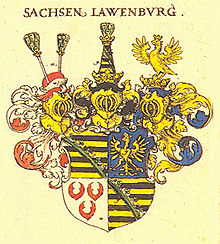Duke of Lauenburg: Difference between revisions
stub |
No edit summary |
||
| (43 intermediate revisions by 23 users not shown) | |||
| Line 1: | Line 1: | ||
[[File:Sachsen-Lauenburg Siebmacher005 - Herzogtum.jpg|thumb|right|The [[coat of arms]] as used in 1605, quartered, with quarter 1 and 4 showing the [[Ascanian]] barry of ten, in [[Or (heraldry)|or]] and [[Sable (heraldry)|sable]], covered by a [[crancelin]] of rhombs (they are not shown in this undetailed copy) bendwise in [[Vert (heraldry)|vert]] (the crancelin symbolises the Saxon ducal crown),<ref>The [[House of Wettin]] also adopted this coat-of-arms, when it gained [[Saxe-Wittenberg]] in 1422, which is why the Ascanian barry of ten reappears in the arms of many (formerly) Wettin-ruled states.</ref> quarter 2 in [[azure (heraldry)|azure]], showing an eagle crowned in or ([[Count palatine|Palgraviate]] of Saxony), and quarter 3 in [[argent (heraldry)|argent]], showing three water-lily leaves in [[Gules (heraldry)|gules]], representing the County of [[Brehna]].]] |
|||
The title '''Duke of Lauenburg''' derives from the [[Duchy of Lauenburg]], which has been ruled by various people since its foundation in [[1269]]. It was held by various countries such as [[France]] from [[1803]] – [[1805]], [[Prussia]] from 1805 – [[1806]], the [[Kingdom of Westphalia]], 1806 – [[1810]], France from 1810 – [[1814]] to the [[House of Oldenburg]] ie (the Kings of Denmark) from [[1814]] – [[1864]]. In 1864, with the [[Second War of Schleswig]], it came under Prussian control. The title along with that of Prince ([[Furst]]) was awarded to [[Otto von Bismarck]], after German Unification in [[1871]]. After his death in 1898, the title along with that of Prince passed to his son [[Herbert von Bismarck]]. |
|||
{{stub}} |
|||
The title of '''Duke of Lauenburg''' derives from the [[Duchy of Saxe-Lauenburg]], which, since its foundation in 1269, was ruled in succession by 29 dukes from six dynastic houses and lines, and by an additional four dukes from a temporary dynastic branch line ([[Anna Maria Franziska of Saxe-Lauenburg]], the first would-be duchess regnant, was kept from inheriting the duchy by male rulers of neighbouring states). |
|||
The [[duchy]] was held by various countries, including [[First French Empire|France]] from 1803 to 1805 and from 1810 to 1814, [[Kingdom of Prussia|Prussia]] from 1805 to 1806, and [[Kingdom of Westphalia|Westphalia]] from 1806 to 1810. The kings of Denmark, members of the [[House of Oldenburg]], held the Duchy of Lauenburg from 1815 to 1864, when the territory came under Prussian control as a result of the [[Second Schleswig War]], though it was not immediately annexed to Prussia. |
|||
In 1865, the [[estates of the Realm|estates]] of Saxe-Lauenburg offered rule of the duchy to King [[William I of Prussia]]. He accepted during the same year, ruling it in [[personal union]] until the estates decided upon the merger of their state with Prussia as of July 1, 1876. |
|||
After the death in 1888 of the last ruling duke, [[Wilhelm I]] (who after 1870 was also German emperor), the now purely honorific title of Duke of Lauenburg was granted to [[Otto von Bismarck]] after his dismissal as [[Chancellor of Germany (German Reich)|Chancellor of Germany]] in 1890. |
|||
==See also== |
|||
* For a list of the dukes, see the [[list of rulers of Saxony#The_Younger_Saxony:_The_Duchy_and_the_Electorate|list of Saxon rulers]] |
|||
* For the duchesses consort, see the [[list of Saxon consorts#Duchess of Saxe-Lauenburg|list of Saxon consorts]] |
|||
==Notes== |
|||
{{Reflist}} |
|||
{{Germany-hist-stub}} |
|||
{{DEFAULTSORT:Duke Of Lauenburg}} |
|||
[[Category:Dukes of Saxe-Lauenburg]] |
|||
Latest revision as of 18:49, 18 April 2021

The title of Duke of Lauenburg derives from the Duchy of Saxe-Lauenburg, which, since its foundation in 1269, was ruled in succession by 29 dukes from six dynastic houses and lines, and by an additional four dukes from a temporary dynastic branch line (Anna Maria Franziska of Saxe-Lauenburg, the first would-be duchess regnant, was kept from inheriting the duchy by male rulers of neighbouring states).
The duchy was held by various countries, including France from 1803 to 1805 and from 1810 to 1814, Prussia from 1805 to 1806, and Westphalia from 1806 to 1810. The kings of Denmark, members of the House of Oldenburg, held the Duchy of Lauenburg from 1815 to 1864, when the territory came under Prussian control as a result of the Second Schleswig War, though it was not immediately annexed to Prussia.
In 1865, the estates of Saxe-Lauenburg offered rule of the duchy to King William I of Prussia. He accepted during the same year, ruling it in personal union until the estates decided upon the merger of their state with Prussia as of July 1, 1876.
After the death in 1888 of the last ruling duke, Wilhelm I (who after 1870 was also German emperor), the now purely honorific title of Duke of Lauenburg was granted to Otto von Bismarck after his dismissal as Chancellor of Germany in 1890.
See also
[edit]- For a list of the dukes, see the list of Saxon rulers
- For the duchesses consort, see the list of Saxon consorts
Notes
[edit]- ^ The House of Wettin also adopted this coat-of-arms, when it gained Saxe-Wittenberg in 1422, which is why the Ascanian barry of ten reappears in the arms of many (formerly) Wettin-ruled states.
